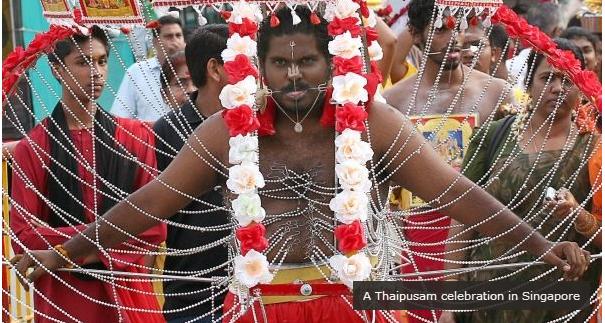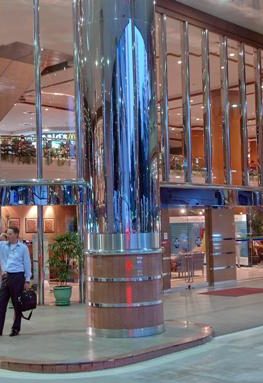Published on February 25, 2010

Southeast Asia is a place of vibrant ethnic and religious diversity. The southern region is dominated by Islamic beliefs but there are also large Christian, Hindu and Buddhist populations and all celebrate their faith regularly and publicly.
span>The end of the fasting month of Ramadan is a big event in Muslim countries such as Indonesia, Brunei and Malaysia. Known as Lebaran in Indonesia (Hari Raya in Malaysia and Brunei) it is a time when Muslims visit family and friends, traditional foods are eaten, new clothing is worn and visits are made to recreational parks. The end of Ramadan begins with mass prayer gatherings early in the morning at mosques, parks and on major streets. Watching rows of hundreds of Muslim women all dressed in white, head-to-toe prayer gowns performing the synchronized prayer ritual is an incredible sight.
Later in the day in Jakarta neighborhoods there are organized games including climbing a greased pole to try to get to the prizes on the top called panjat pinang. It is also customary to give out money to children in poor neighborhoods – a gift of 500 or 1,000 rupiah will bring a smile that is remembered forever.
In Brunei, the end of Ramadan involves three days of celebrations and the first day is the only day of the year that the Istana Nurul Iman royal palace is open to the public. In December, Muslims commemorate Prophet Ibrahim with the Festival of Sacrifice. This involves the sacrifice of cows and goats with the meat being given to the poor, as well as friends and family.
In Malaysia’s Sabah state, Sabah Kaammantan (aka Harvest Festival) in May is the native festival of the Kadazan-Dusun, Sabah’s largest ethnic group.The Harvest Festival is a celebration in honor of Bambaazon, the spirit of the rice padi. The highlight is near the state capital Kota Kinabalu, where for two days people play traditional sports like arm wrestling, blow-dart shooting and relay racing with sticks. Ancient traditions such as the Magavau, a cleansing and blessing ritual performed by the Bobohizan (high priestess) co-exist with recent additions such as a Beauty Queen contest.Also, during the festival, ‘tapai’, a popular and potent local rice wine flows freely.
Another notable festival in Malaysia is the Tamil Hindu celebration of Thaipusam. At the full moon in late January, many thousands of worshippers congregate at the entrance of the Batu caves north of Kuala Lumpur to ask Lord Muraga, the god of war, to cleanse their sins and to ask for good health and prosperity in the coming year. Accompanied by hypnotic ####### drums, some participants pierce their face with metal spikes and insert hooks into their body before slowly climbing the steps to the temple in the caves.
Thaipusam is also celebrated in the multi-religious Singapore, along with Deepavali, the Festival of Lights in October/November when Hindus adorn their homes with lights and oil lamps. Singapore also hosts big Chinese and Buddhist celebrations such as the Lantern Festival (September/October) which involves the lighting of fireworks, folk dancing and floating lanterns on the lake. Locals head to the gardens at night to eat Chinese pastries and mooncakes while lion dancers wander the streets accompanied by a cacophony of cymbals and drums. Vesak Day in April/May celebrates Buddha’s birth, enlightenment and death and is marked by the release of caged birds, the giving of gifts to the poor and mass candlelight processions with thousands of devotees chanting sutras.
The vast majority of Filipinos are Catholic but they celebrate their faith like no other country and barely a day goes by when there is not a festival (fiesta) in some part of the country. The month long Feast of the Child Jesus honors the young Jesus and consists of processions and performances. Perhaps the wildest celebration is the Ati-atihan festival held on the third weekend of January. Participants wear colorful costumes, paint their bodies black and perform tribal dance to the distinctive beat of “Hala bira”.
The Easter holy week features dramatizations of the Passion of Christ which sometimes include acts of self-flagellation. Villagers of San Pedro, Cutud (and elsewhere in the Philippines) perform the ancient ritual on the morning of Good Friday, whipping and cutting their backs, arms, and legs with burillo whips. The climax happens at midday when young male penitents are literally nailed to crosses.
The Flores de Mayo, known as the Queen of Filipino Festivals, is a week-long festival held in May which sees street processions in almost every town honoring Queen Helen and Constantine. Beautiful, young Filipinas accompanied by handsome escorts walk the streets under elaborately adorned hand-carried bamboo arcs. The Philippines also has the longest Christmas celebration in the world, starting on the 16th of December and ending on the 6th of January, with huge masses and gatherings to celebrate the birth of Jesus.
Stuart Clarke is a freelance writer based in Bangkok who has written articles for The Age and Sydney Morning Herald newspapers and Rolling Stone magazine.






